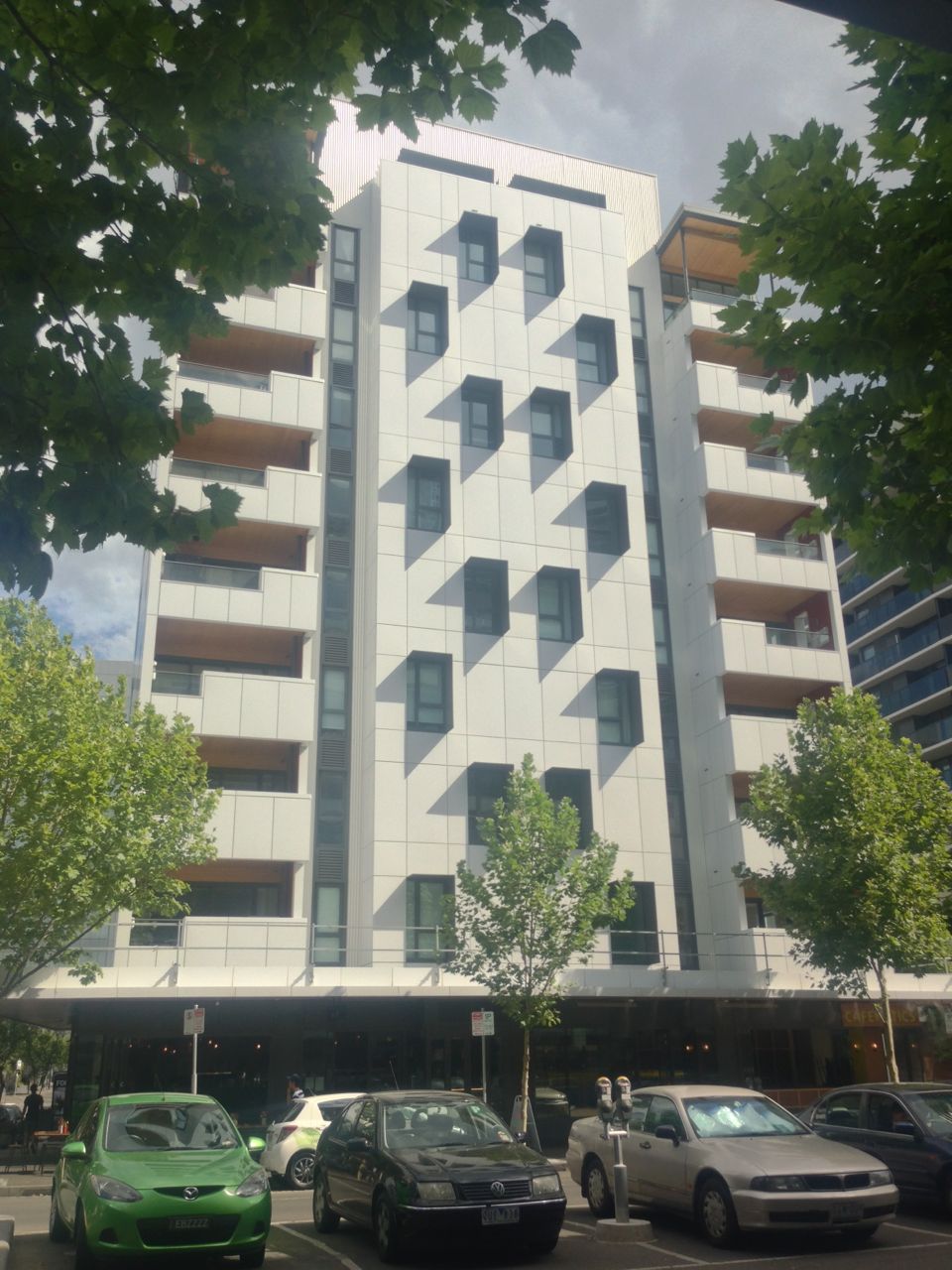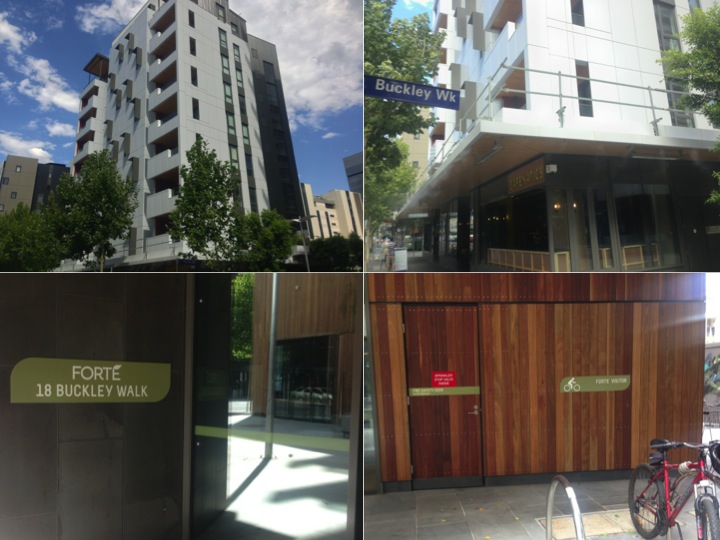Just a short walk from downtown Melbourne is one very unique 10-story apartment building. Built in 2012, Forte does not look very different than its neighboring high-rise apartments. It just happens to be the world’s tallest wood building.
Forte has been constructed and heavily marketed for its sustainable practices for a high-end residential market. The most innovative approach is the use of an all-wood structure.
Making such heights possible in wood is the use of Mass Timber, in the case of Forte, solid Cross Laminated Timber (CLT).
Rather than traditional wood frame construction, Mass Timber resembles concrete structures in their assembly, massing, and strength. Essentially solid wood panels and columns take the place of poured concrete slabs and beams.
Read more about Forte at www.forteliving.com.au

Why build high-rise in wood?
Tall buildings will continue to be needed into the future. UN Habitat estimates 3 Billion people will demand new affordable homes in the next 20 years, primarily in cities. Tall buildings are essential to provide density adequate for public transportation, reducing the overall environmental impact of residents.
Steel and concrete have served well as structural materials, but one big issue is changing the game: Climate change and carbon emissions.
As buildings become more energy efficient in their operation, the embodied energy and carbon footprint of the construction process become more important. The production of steel and concrete account for 8% of the world global carbon emissions.
Using wood as the primary structural material has the ability to reduce embodied energy by 60-75% compared to concrete and steel. Building in wood not only reduces the carbon emissions of material production, the wood has the potential to store carbon from the atmosphere.
Other benefits of building in wood rather than concrete and steel:
- Wood is a rapidly renewable resource
- Reduced building weight
- Reduced foundation size and material needs
- Accelerated construction schedule through preassembly
- Reduced thermal bridging of the building structure
- Reduced risk from escalating energy costs on material pricing
- Potential price benefits in locations with CO2 emissions taxes
Growing Industry Support
Two reports have recently been published on the feasibility of tall wood structures in North America.
Skidmore, Owings & Merrill, LLP is a leading US architecture firm for high-rise construction, currently working on the new One World Trade Center. They have produced the “Timber Tower Research Project” describing a prototype of a 40+ story residential tower in Chicago.
A second study authored by architect Michael Green “The Case for Tall Wood Buildings” outlines potential designs pushing to 30 stories in Vancouver, Canada. Green has been at the forefront of demonstrating the potential for high-rise wood construction. See his innovative TED Talk here: www.ted.com/talks/michael_green_why_we_should_build_wooden_skyscrapers.html
Both studies show buildings in all wood are feasible up to 15-20 stories. Above this unique loads allow for wood to be used on most structural components with steel or concrete supports and connections. Both studies indicate structurally sound buildings 30-40+ stories in height using primarily wood.
The North American market has yet to realize the potential for tall wood structures, and will need to take examples and research from other areas of the world. In addition to Forte in Melbourne, Europe has many examples of Mass Timber mid and high rise construction.
With the growing need for carbon emissions reductions, the huge amounts of energy used to produce concrete and steel will play a growing importance in our material choices. Wood offers a natural alternative worth exploring.
Read on for a more in depth discussion of the obstacles of wood in the current building industry.

Additional Commentary: Existing Obstacles
As new buildings continue to use Mass Timber, adoption and code regulation will need to be adjusted to take into account the unique aspects of wood construction.
Addressed below are specific issues typically raised in discussing wood. Several issues will require further input and research.
- Building Code: Current code does not allow high-rise buildings over 6 stories to be built out of a combustible material such as wood. Using a performance based approach mass timber buildings can be demonstrated to perform equally well in structural and fire considerations.
- Fire Safety: Mass timber reacts differently in a fire than stick frame wood. Mass Timber chars at a known rate, and the remaining layer retains structural integrity. Using design methods such as charring and encapsulation, buildings have been proposed to meet a performance-based approach to fire safety. Additional fire testing of actual assemblies is needed for optimum detailing.
- Structural integrity: Mass Timber has been found to provide adequate strength and durability to handle structural loads. The tallest trees in the world grow up to 40 stories in height. Buildings over 15 stories will likely need a combination of materials to take advantage of the unique benefits of each material.
- Michael Green proposes structural steel in specific locations to transmit loads using a strong column-weak beam structural approach.
- SOM proposes concrete connection beams to reduce beam sizes and strengthen the floor assembly against wind loads. This adds the benefit of extra building mass to reduce uplift loads.
- Water Management: The life of any structural material is impacted by water intrusion. Steel rusts, concrete degrades, and wood rots. Proper moisture management is essential in any building design and is no different building in wood. Research of details will be needed to ensure long-term durability.
- Construction: Current trades do not exist in large-scale timber construction, however the construction method is similar to concrete tilt up. Existing companies specializing in concrete high-rise construction are most applicable to take on the challenge of high-rise wood buildings.
- Schedule: It is estimated wood structures will be quicker to construct due to pre-assembly off site. As more buildings are constructed the efficiency will be gained through experience.
- Insurance: Likely extra insurance will be needed during construction due to the increased risk of fire damage. It is not well known what the insurance requirements will be until actual underwriting is established in actual buildings.
- Architectural Design: Both studies show no significant impacts to the interior architectural considerations using a wood structure.
- Development and Rental: Both studies show no impact on the flexibility of building layout or rentable space using wood as a primary structural material. However, as height increases above 15 stories the need for interior shear walls limits flexibility to more residential uses. Office plans typically require more open floor plans.
- Indoor Air Quality: Unlike Urea-Formaldehyde, the higher strength formaldehyde adhesives used in Mass Timber do not have the same off-gassing properties and pose little risk to indoor air environments.
- Sustainable Forestry: It is essential if widespread wood building is adopted to utilize sustainable forestry. Otherwise the carbon emissions benefits are lost through deforestation. Wood buildings will need to be conscious of the source of wood materials.
- End of life disposal: In order to secure the benefit of carbon sequestration in the building material, proper end of life uses must be considered. Otherwise the stored carbon will merely be delayed in its release to the atmosphere if burned of landfilled.
- Public Perception: A significant hurdle to developers taking on additional risk of early adoption is the public and industry perception of wood as a building material. With proper research and building techniques, perceptions can be shifted. Likely early adoption will be in the public sector, or high end residential promoting the sustainability benefits of reduced carbon footprint.
Additional Resources:
Timber Tower Research Project: https://www.som.com/sites/default/files/20130506_SOM-Timber-Tower-Final-Report_2.pdf
Making the Case for Tall Wood Buildings: http://wecbc.smallboxcms.com/database/rte/files/Tall%20Wood.pdf
Forte: www.forteliving.com.au
Our Mission
NESEA advances sustainability practices in the built environment by cultivating a cross-disciplinary community where practitioners are encouraged to share, collaborate and learn.





Add comment